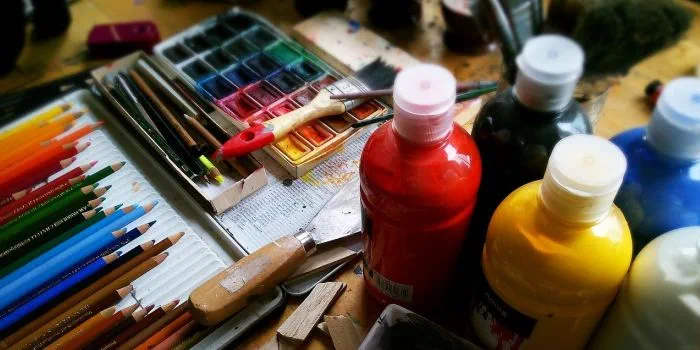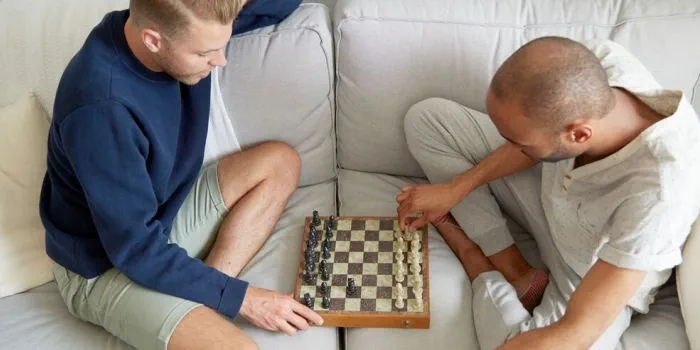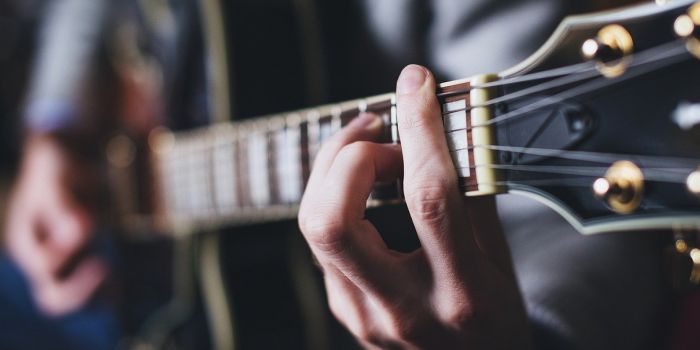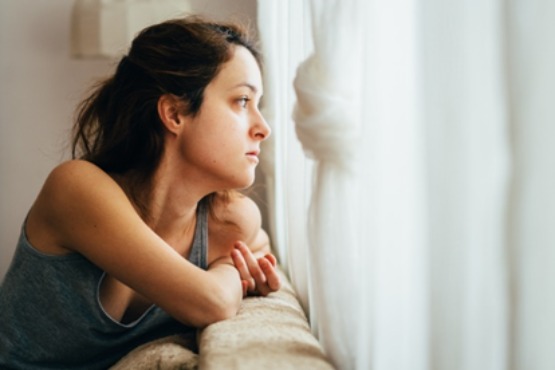How do creative hobbies benefit your health?
When we think of the things that are beneficial to our wellbeing, it’s likely that we think of exercise and diet. But creative hobbies can also boost your mental and emotional health. Why is creativity so good for us? And how can you be more creative? Here, I explain how creativity can benefit your health and how to introduce creativity into your routine.

What are the health benefits of creativity?
Creativity and imagination are important for children to develop because it helps them be resourceful. But these qualities are important in adults, too. Creative outlets not only help to reduce feelings of stress and loneliness but can improve your mood and even affect how your brain works. And they’re fun!
Whether it’s drawing, singing, playing music, writing, baking, dancing or gardening, having a creative outlet can work wonders for your mind. Here are some of the ways that different types of creative activities can benefit you.
So, why is being creative good for you?
1. Creativity can get you into a state of flow
There are many ways that creative hobbies can positively affect your wellbeing. One of the most noticeable effects is that taking part in a creative task can help you get into a state of flow. This happens when you’re completely focused on a task, to the point where you think less about things that are worrying you. Being this absorbed can be rewarding and enjoyable – especially because you’re more likely to get into a flow state if the task is challenging enough.
Bupa Lead Behavioural Insights Advisor, Sarah Griffiths, enjoys completing jigsaw puzzles for this reason. “I love how I can be completely absorbed for periods of time. It’s great if I’m feeling stressed to just take some time from thinking about other things. It could just be for half an hour or for longer. I like large and tricky puzzles, and I can also listen to podcasts at the same time.”
2. Creativity can reduce stress and improve mental health
Several studies have shown that creative hobbies, such as art, writing and music, can reduce and even prevent stress. You may find that, after a stressful day, enjoying a hobby can help you de-stress and even give you an energy boost. Being creative may also reduce feelings of anxiety and depression, and can help us express or manage our emotions in a positive and productive way. Especially when those feelings are difficult to put into words.
3. Hobbies can help you socialise
Hobbies don’t have to be done on your own – they can also be a way to socialise with others who share the same interest. If you enjoy reading, for example, you could join a book club; or if you like drawing or painting, you could join an art class. Group activities like these can be a great way to meet new people. And being socially connected also has a positive effect on our wellbeing.

4. Creativity affects brain function
Different parts of your brain are activated when you take part in creative activities. For example, research has shown that musicians have better connectivity between the left and right parts of their brains. This can help to improve cognitive function (the way your brain works). Simply listening to music can also stimulate your brain, and has been shown to improve cognitive function in people who have had a stroke.
For Graham, a parent, playing a musical instrument also provides mindful relaxation. “I really enjoy playing the acoustic guitar. There’s something very relaxing and mindful about sitting down, playing different chords and finger-picking patterns and seeing where it takes me.”
“I also love the feeling of the steel strings as I strum them and experimenting with the different sounds that I can create. Sometimes I’ll start forming ideas for a song, and a few words of lyrics will come into my head that might fit over the top. I could happily sit there for hours doing this, if I had the time,” he adds.
But if you’re more interested in writing than playing an instrument, try writing things down using the old-fashioned method of a pen and paper. The physical act of writing something down activates areas in your brain that are involved in language and memory.

Fun ways to get creative
So, now that we know that creativity is good for our health, how do we make the time do it? Balancing work and other commitments with creative activities can be difficult. But it’s possible to incorporate creativity into our busy lives and achieve a good work-life balance. Key to this is managing your time and making your hobby a part of your routine, if you can.
Sarah suggests you start small. “As with other habits, if you’re starting something new then it’s best to start small before trying anything more advanced or buying specialist equipment. You don’t want to feel pressured to spend time on a new hobby. So, see how you can fit it into your everyday life, and if you get enjoyment from it.”
Still stuck for ideas and need a creative nudge? Here are some of the different ways you can engage in a creative activity and boost your wellbeing.
- Colour pencil drawing. Do a small, coloured pencil drawing every day for a year and see how your observation and drawing skills improve. By the end of the year, you’ll be a lot better and will have a collection of art as a tangible result. And you won’t need lots of equipment to start with – if you find you enjoy it, you could always try painting next.
- Photography. Taking a photo is very easy if you have a smartphone. This also encourages you to pay fresh attention to what is around you visually, which we normally have no reason to notice.
- Write one short story a month. Many of us may not have written an imaginative story since being at school. A short story can be just a couple of pages long and start with a simple question you have. Finishing a story can also be very fulfilling. Or, if you have an idea for a longer story, jot it down and see where it takes you. Writing can help develop research and analytical skills, interest in other languages, and is creative too.
- Try knitting, crochet or sewing. The repetitive action of knitting, crochet and sewing can be relaxing, while still being creative. If you’re feeling adventurous, you could try more complex patterns as you get better with practice.
- Bake a cake. Baking is not only a creative outlet, but it can also be stress-relieving and fulfilling when you get to eat the end result! Or, even better, give your freshly baked creations to close ones such as friends or family.
- Start a journal. Simply writing your thoughts down on the page can be therapeutic, and it can be fun to look back on happy memories. You could include drawings, too. If you’re stuck about where to start, you could find some journal prompts online.
- Make a scrapbook. Do you keep tickets from concerts or journeys you’ve gone on? Why not turn them into art and stick them in a scrapbook? You can get creative with the layout and the design, while keeping your mementos safe.
- Get green. Looking after plants and watching them flourish is a satisfying and relaxing hobby for many people. You don’t need to have a garden, either – indoor plants have similar benefits, and being around greenery is good for your mental health.
Are you interested in learning more about your health? Discover more about our range of health assessments.
Co-authors
Fatmata Kamara, Mental Health Nurse Global Case Manager and Dr Sarah Griffiths, Lead Behavioural Insights Advisor.
-
Sources Sources
- Expressive arts and design - imagination and creativity. UK Government. gov.uk, accessed February 2023
- Martin L, Oepen R, Bauer K et al. Creative Arts Interventions for Stress Management and Prevention-A Systematic Review. Behav Sci (Basel) 2018;8:28. doi:10.3390/bs8020028
- Beaty RE, Benedek M, Silvia PJ, Schacter DL. Creative Cognition and Brain Network Dynamics. Trends Cogn Sci 2016;20:87-95. doi:10.1016/j.tics.2015.10.004
- Galassi F, Merizzi A, D’Amen B, Santini S. Creativity and art therapies to promote healthy aging: A scoping review. Front Psychol 2022;13:906191. doi:10.3389/fpsyg.2022.906191
- Pauly T, Chu L, Zambrano E, Gerstorf D, Hoppmann CA. COVID-19, Time to Oneself, and Loneliness: Creativity as a Resource. J Gerontol B Psychol Sci Soc Sci 2022;77:e30-35. doi: 10.1093/geronb/gbab070
- Israel SM, Adams-Price CE, Bolstad CJ, Nadorff DK. Age and recognition for one’s creative hobby are associated with fewer depressive symptoms in middle-aged and older adults. Psychol Aesthet Creat Arts 2022;16:610-617. doi:10.1037/aca0000366
- Van der Linden D, Tops M, Bakker AB. The Neuroscience of the Flow State: Involvement of the Locus Coeruleus Norepinephrine System. Front Psychol 2021;12:645498. doi: 10.3389/fpsyg.2021.645498
- Effortless attention in everyday life: a systematic phenomenology. Effortless Attention: A New Perspective in the Cognitive Science of Attention and Action. Bruya B (ed). MIT Press, April 2010
- Stuckey HL, Nobel J. The Connection Between Art, Healing, and Public Health: A Review of Current Literature. Am J Public Health 2010;100:254-263. doi:10.2105/AJPH.2008.156497
- Social connections and the brain. Age UK. ageuk.org.uk, last updated September 2022
- Kaimal G, Ray K, Muniz J. Reduction of Cortisol Levels and Participants' Responses Following Art Making. Art Ther (Alex) 2016;33:74-80. doi:10.1080/07421656.2016.1166832
- Sun J, Chen Q, Zhang Q, et al. Training your brain to be more creative: brain functional and structural changes induced by divergent thinking training. Hum Brain Mapp 2016;37:3375-3387. doi:10.1002/hbm.23246
- Demarin V, Bedekovic MJ, Puretic MB, Pasic MB. Arts, brain and cognition. Psychiatr Danub 2016;28:343-348
- Kawasaki A, Hayashi N. Musical instrumental reading affects middle cerebral blood flow and cognitive function. Front Psychol 2022;13:966969. doi:10.3389/fphys.2022.966969
- Umejima K, Ibaraki T, Yamazaki T, Sakai KL. Paper Notebooks vs. Mobile Devices: Brain Activation Differences During Memory Retrieval. Front Behav Neurosci 2021;15:634158. doi: 10.3389/fnbeh.2021.634158
- Plants to help ease the mind. Thrive. thrive.org.uk, accessed February 2023
About our health information
At Bupa we produce a wealth of free health information for you and your family. This is because we believe that trustworthy information is essential in helping you make better decisions about your health and wellbeing.
Our information has been awarded the PIF TICK for trustworthy health information. It also follows the principles of the The Information Standard.

More mental health and wellbeing articles
Did you find our advice helpful?
We’d love to hear what you think. Our short survey takes just a few minutes to complete and helps us to keep improving our healthy lifestyle articles.
Legal disclaimer
This information was published by Bupa's Health Content Team and is based on reputable sources of medical evidence. It has been reviewed by appropriate medical or clinical professionals and deemed accurate on the date of review. Photos are only for illustrative purposes and do not reflect every presentation of a condition.
Any information about a treatment or procedure is generic, and does not necessarily describe that treatment or procedure as delivered by Bupa or its associated providers.
The information contained on this page and in any third party websites referred to on this page is not intended nor implied to be a substitute for professional medical advice nor is it intended to be for medical diagnosis or treatment. Third party websites are not owned or controlled by Bupa and any individual may be able to access and post messages on them. Bupa is not responsible for the content or availability of these third party websites. We do not accept advertising on this page.







